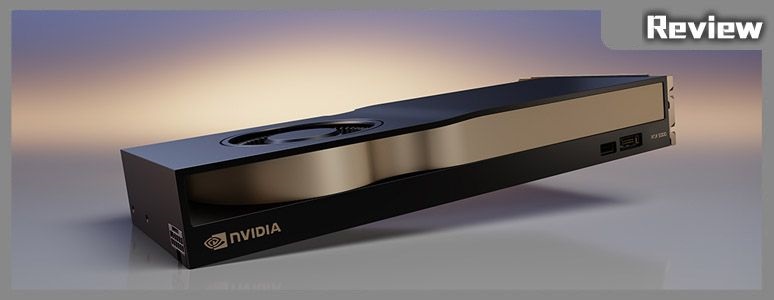
The NVIDIA Ada Lovelace generation ushers in a new era of professional graphics cards with the NVIDIA RTX™ 5000 Ada Generation (hereafter referred to as RTX 5000). This advanced card features upgraded CUDA cores, third-generation RT cores, and fourth-generation Tensor cores. It boasts a lower power consumption of 250W, is equipped with 32GB GDDR6 ECC memory, and supports virtualization, Quadro Sync II, RTX Desktop, and exclusive enterprise functions. It’s an ideal upgrade for professionals with diverse computing needs. The professional graphics card sales and support services are provided by NVIDIA’s long-term partner, LEADTEK Technology.
Specifications:
- GPU Architecture: NVIDIA Ada Lovelace
- CUDA Cores: 12,800
- NVIDIA Tensor Cores: 400
- NVIDIA RT Cores: 100
- Single Precision Performance: 65.3 TFLOPS
- RT Core Performance: 151.0 TFLOPS
- Tensor Performance: 1044.4 TFLOPS
- GPU Memory: 32 GB GDDR6 ECC
- Memory Interface: 256-bit
- Memory Bandwidth: 576 GB/s
- Maximum Power Consumption: 250 W
- Graphics Bus: PCI Express 4.0 x16
- Display Connectors: DP 1.4 x4
- Dimensions: 4.4″ H x 10.5″ L, dual-slot
- External Power Connectors: 1x PCIe 12+4 pin
- Synchronization Output: Supports Quadro Sync II
- Encode/Decode Engines: 2x encode, 2x decode (+AV1 encode/decode)
Same as AD102 core NVIDIA RTX 5000 Ada Generation professional graphics card
Modern professional tasks, including image processing, AI, 3D rendering, VFX, simulations, and computations, can benefit significantly from GPU acceleration. This acceleration results in faster processing times. NVIDIA has been at the forefront of this revolution, starting with CUDA for general GPU computations and progressively evolving Tensor and RT cores. These advancements have enabled convenient development features in hardware, leading to real-time ray tracing in 3D rendering, combined with AI processing, robotics simulation, and the creation of the Omniverse platform using OpenUSD.
Our previous assessment of the flagship NVIDIA RTX 6000 Ada Generation (hereafter referred to as RTX 6000) highlighted its robust AD102 core and 48GB GDDR6 ECC memory. However, its single-card cost and 300W power consumption might be slightly steep for small and medium-sized businesses and laboratories looking to upgrade to the Ada generation. Consequently, NVIDIA has recently expanded its Ada Generation lineup with new cards like the RTX 5000, RTX 4500, and RTX 4000, catering to the diverse upgrade needs of various professional users.
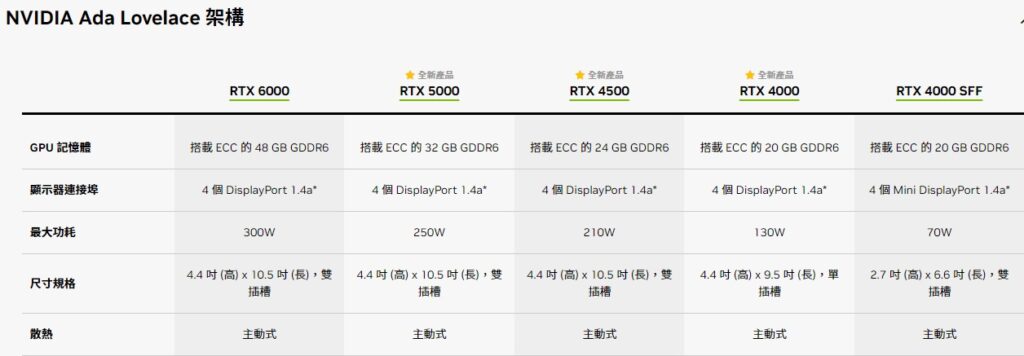
The RTX 5000, featuring the AD102 core, has been streamlined to include 100 Streaming Multiprocessors (SMs). It boasts specifications like 12,800 CUDA cores, 400 Tensor cores, and 100 RT cores. This model is equipped with 32GB of GDDR6 ECC memory, utilizing a 256-bit memory interface and achieving a memory bandwidth of 576GB/s. Notably, the GPU’s power consumption is only 250W, which can be supported by a single PCIe 16-pin power connector or through an adapter using two PCIe 8-pin connectors. This efficient power requirement makes the RTX 5000 a viable upgrade for most professional workstations.
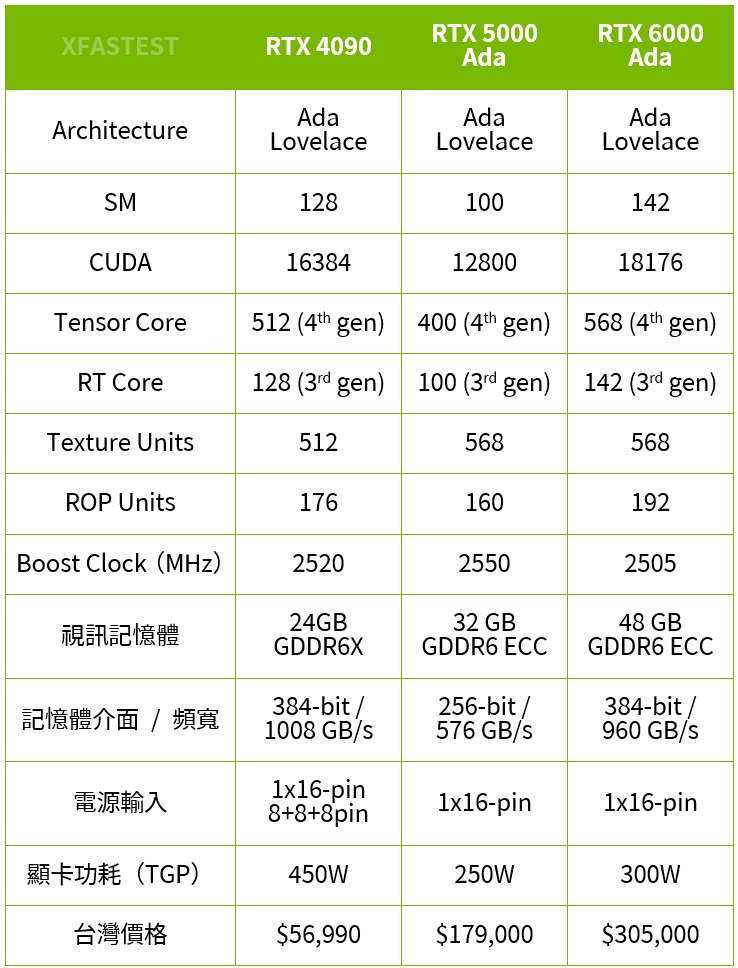
The primary distinction between NVIDIA’s RTX professional graphics cards and GeForce RTX gaming cards lies in their configuration. The professional cards come with larger GDDR6 video memory and support ECC (Error Correcting Code) for enhanced reliability. They also operate at more stable clock speeds and have lower power consumption settings.
NVIDIA’s RTX professional graphics cards cater to a broader range of enterprise applications. They support features like RTX Virtual Workstation (vWS), dual fifth-generation NVDEC decoding engines, eighth-generation NVENC encoding engines, Mosaic multi-display technology, RTX Desktop Manager, Quadro Sync II, and other enterprise management tools.
Furthermore, NVIDIA’s professional graphics cards are primarily sold through partners. For instance, cards sold by Leadtek Technology come with a ‘three-year warranty’ which includes ‘door-to-door service’ and access to a ‘0800-600-206’ technical service hotline, providing comprehensive technical support and services to businesses and customers. This level of support and service is a major differentiator from gaming graphics cards.
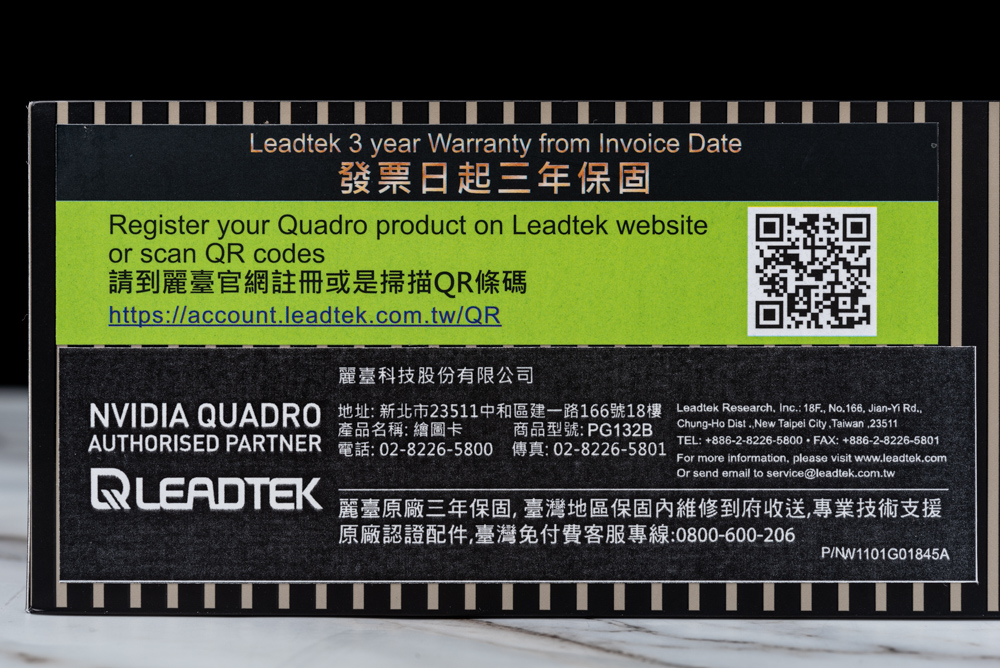
NVIDIA offers two distinct driver branch versions for its professional graphics cards: the ‘Official Branch/Studio’ and the ‘New Feature Branch’. In essence, the ‘Official Branch/Studio’ is designed to deliver optimal stability and performance. It includes ISV certifications, a longer life cycle, and the most stable version with security updates. On the other hand, the ‘New Feature Branch’ focuses on providing the latest driver features, bug fixes, and operating system support.
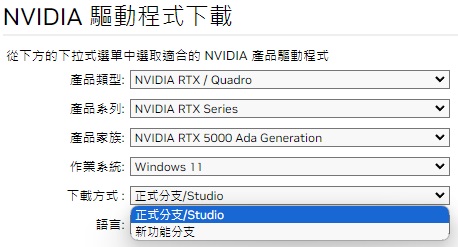
NVIDIA RTX™ 5000 Ada Generation professional graphics card unboxing / 26.7cm long, 2-slot, blower fan workstation design
The RTX 5000 professional graphics card features a sleek, matte black design with signature dark gold accents embellishing its sides, a classic look for this generation. Measuring 26.7 cm in length, it fits comfortably in a 2-slot installation space. The card’s design includes a single blower-style fan, making it ideal for workstation setups that require multi-card systems and consistent airflow through the cooling system.
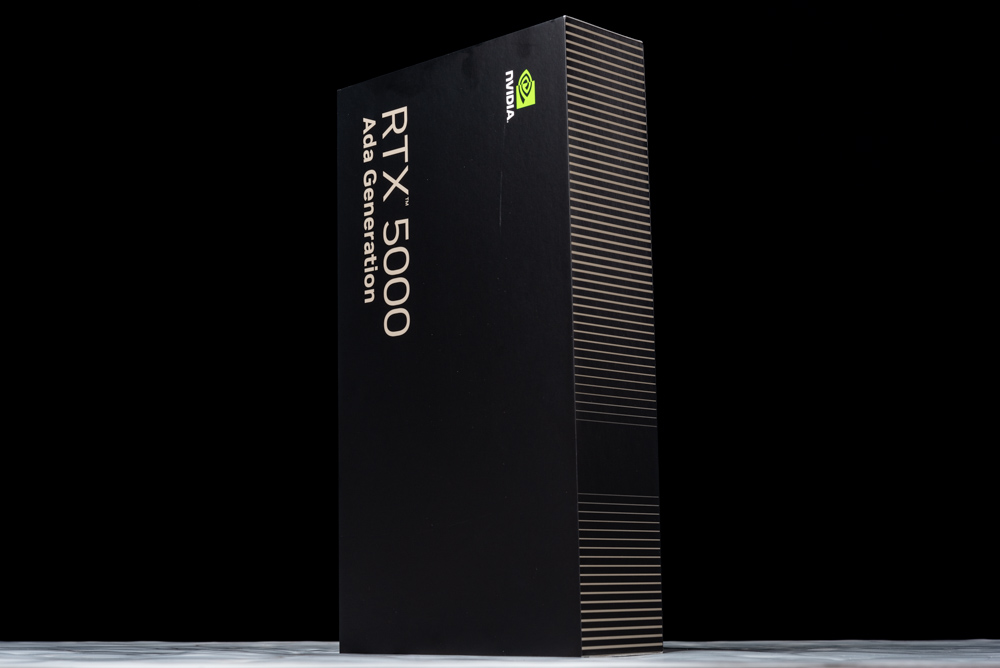
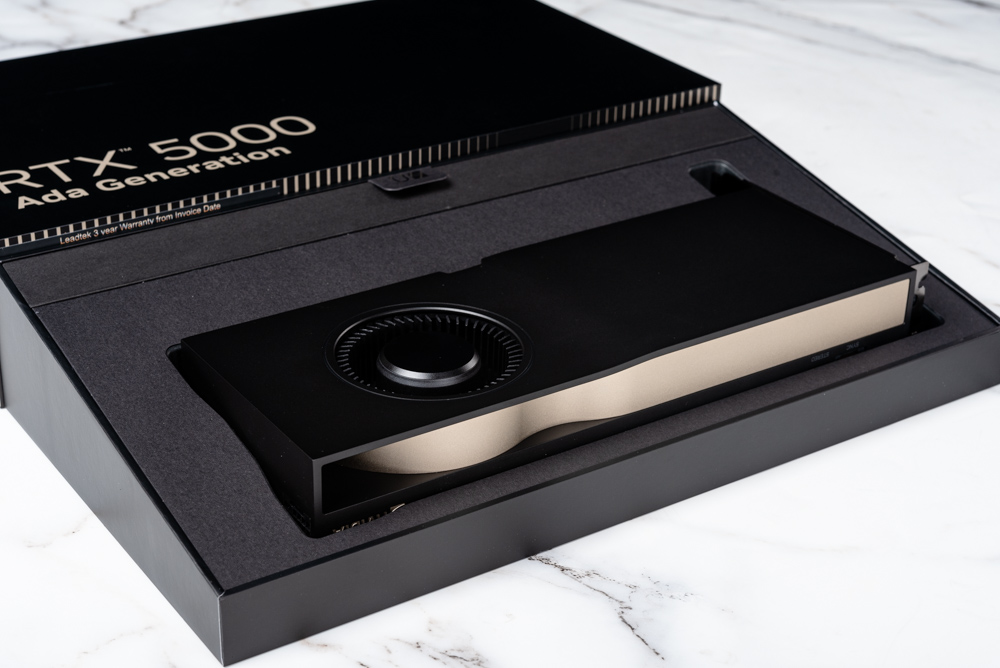
Contrasting with the glossy black style of the RTX 6000, the RTX 5000 sports a unique matte black finish complemented by sharp, geometric lines. Its design includes a traditional blower-style fan, a less common feature in modern cards. The dark gold-colored edging and the unique curved design on the side of the card add a distinctive aesthetic appeal, setting this professional graphics card apart in terms of design.
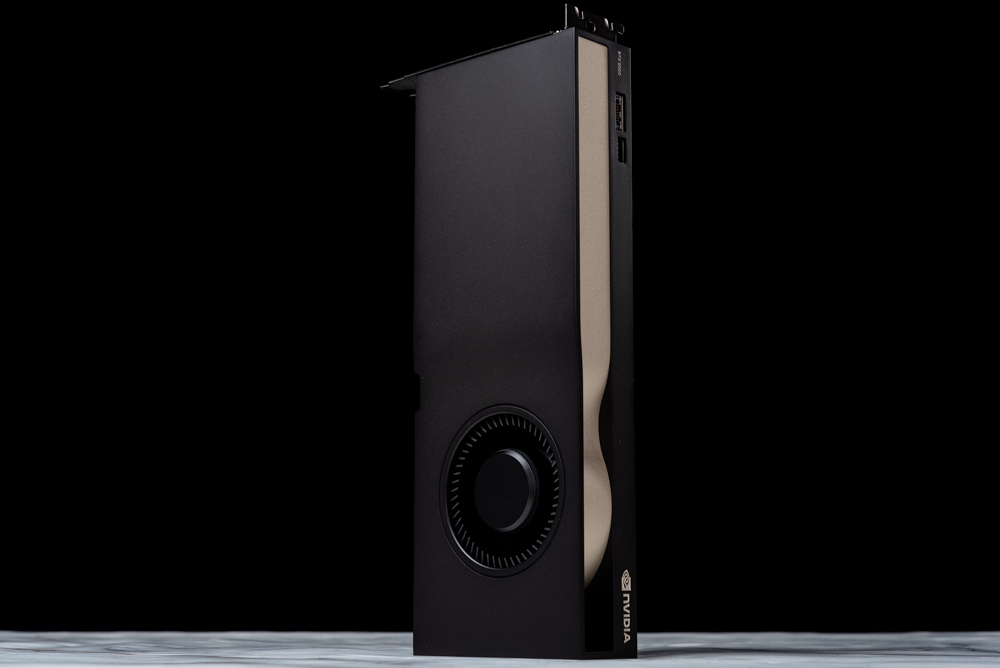
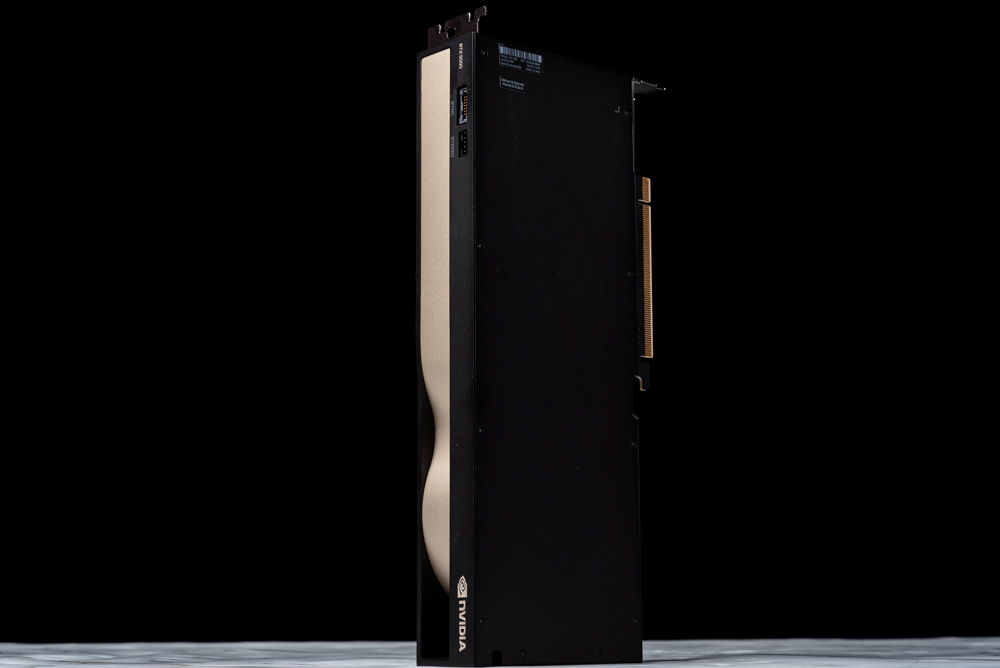
On the upper left side of the RTX 5000 graphics card, you’ll find the interface for Quadro Sync II. Moving to the front of the card, it proudly displays the NVIDIA logo along with the PCIe 16 pin 12VHPWR power connector. The card comes with an accessory – a converter cable that transitions from PCIe 16 pin to dual PCIe 8 pin connectors. This inclusion is particularly useful for workstations and servers undergoing upgrades, as it eliminates the need to replace the power supply unit.
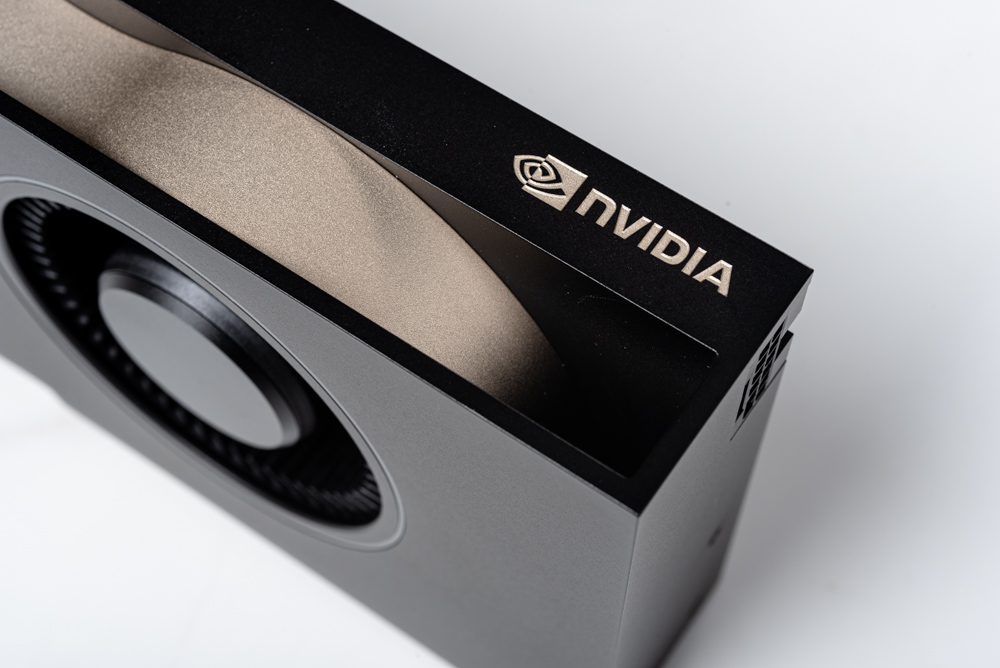
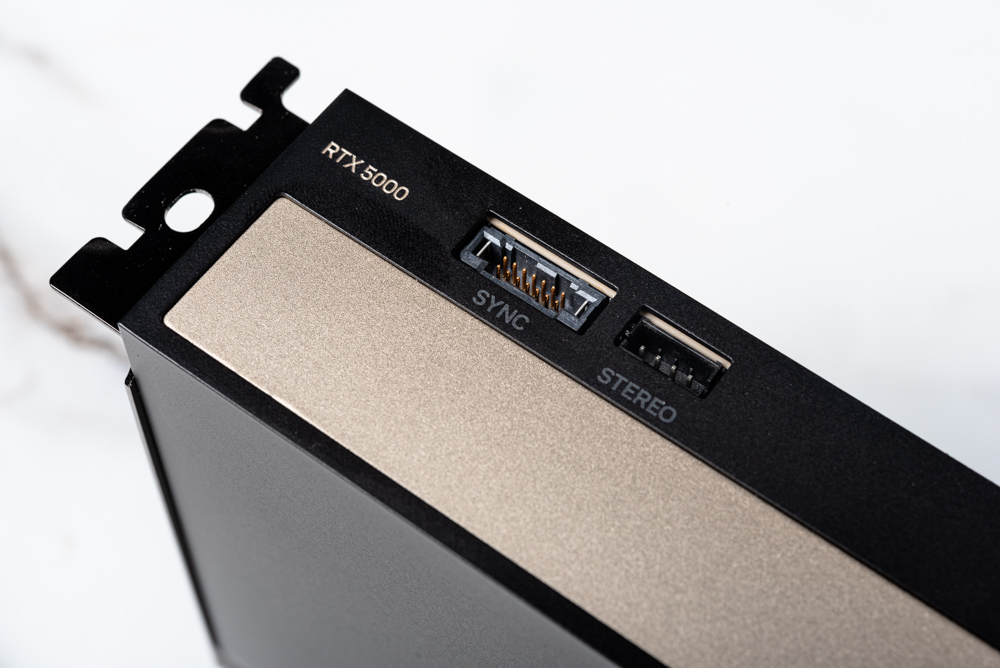
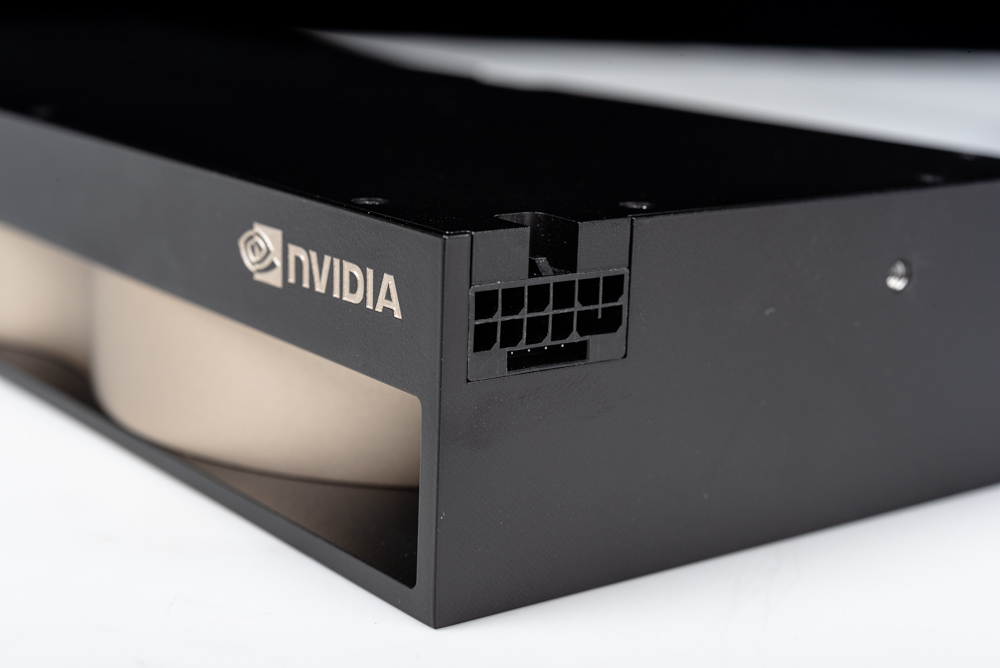
The RTX 5000 professional graphics card is equipped with four DisplayPort 1.4 ports, offering extensive connectivity options. Included in the accessories is a DP 1.4 to HDMI adapter, enhancing its versatility. The card is capable of powering up to four 4K@120Hz or two 5K@60Hz professional displays simultaneously. It supports output to two ultra-high-resolution 8K@60Hz screens, making it a formidable choice for high-end visual output requirements.
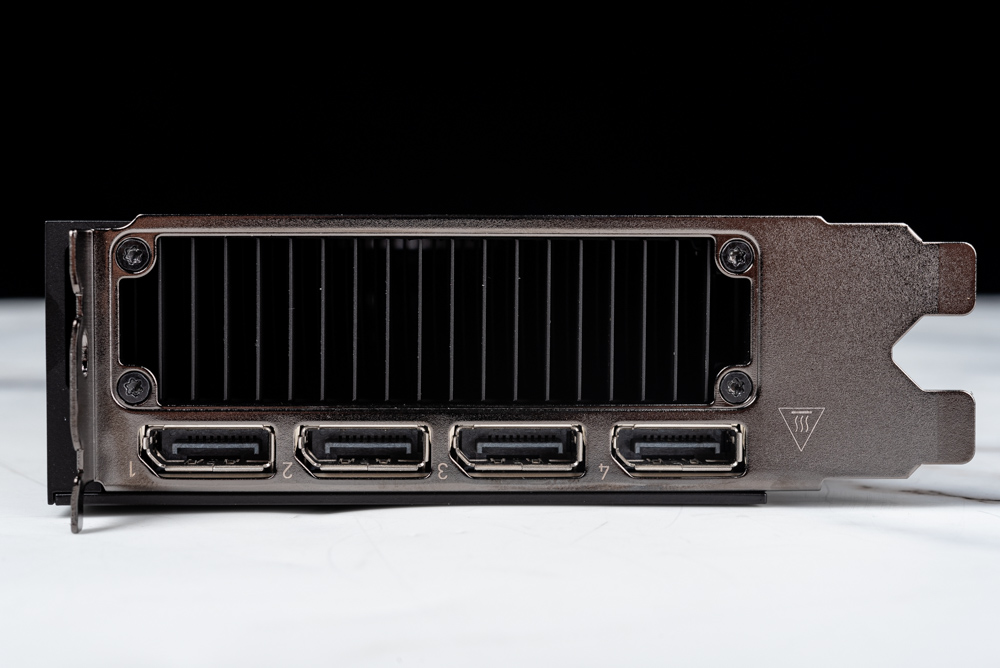
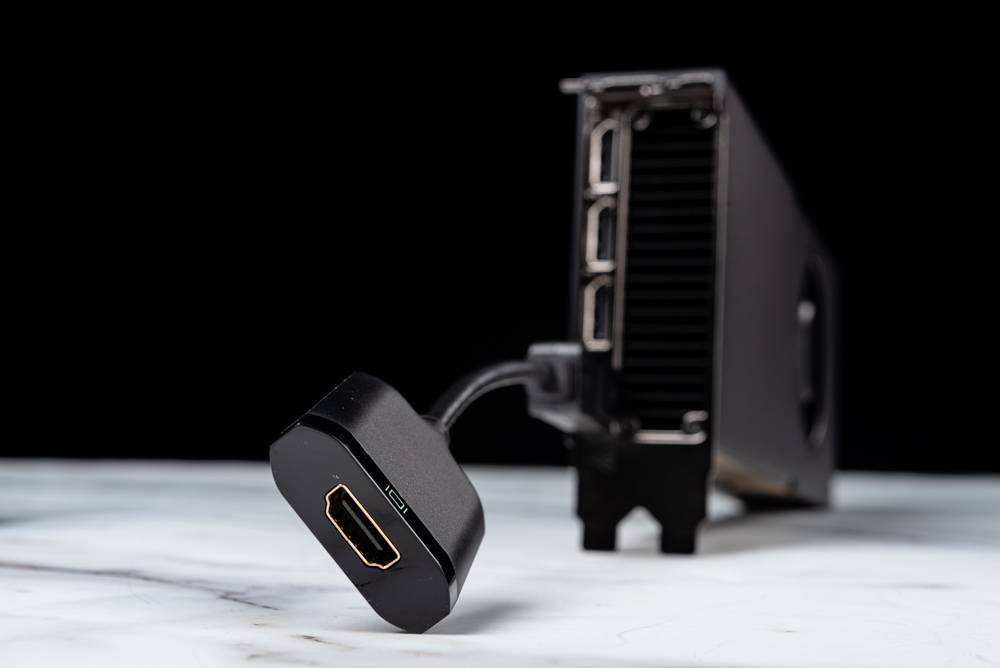
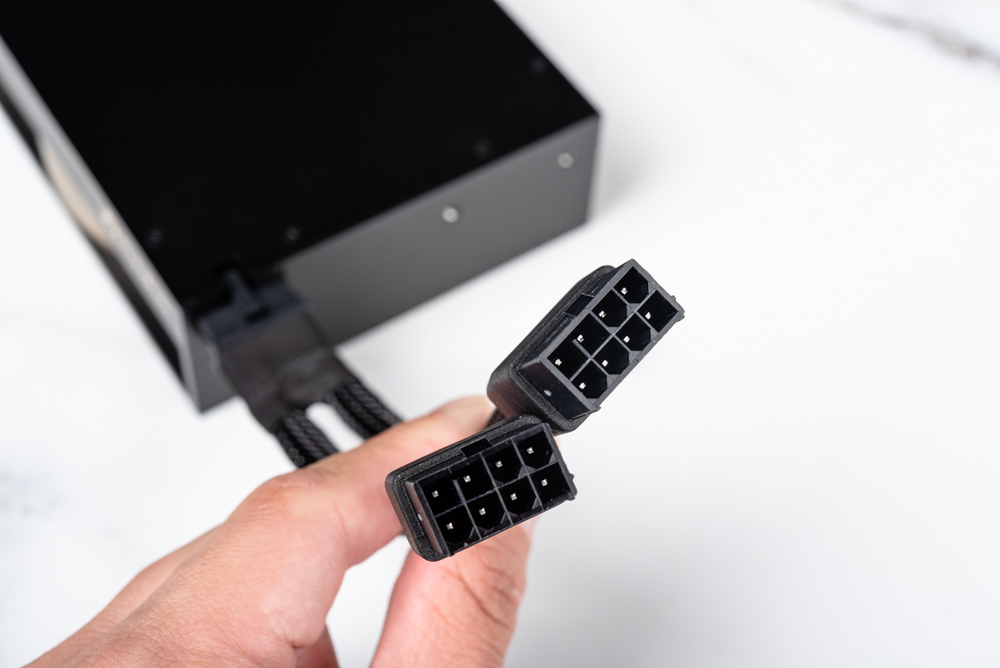
NVIDIA Control Center, ECC, Mosaic, RTX Desktop
The RTX 5000 is equipped with 32GB of GDDR6 ECC memory, with the ECC (Error Correcting Code) function enabled by default to enhance data reliability. Users can adjust the ECC settings through the NVIDIA Control Center, where they have the option to turn the ECC feature on or off. Given that professional computing and simulation tasks often require extended periods, the ECC feature of the RTX 5000’s memory plays a crucial role in increasing the precision and reliability of workstation computations.
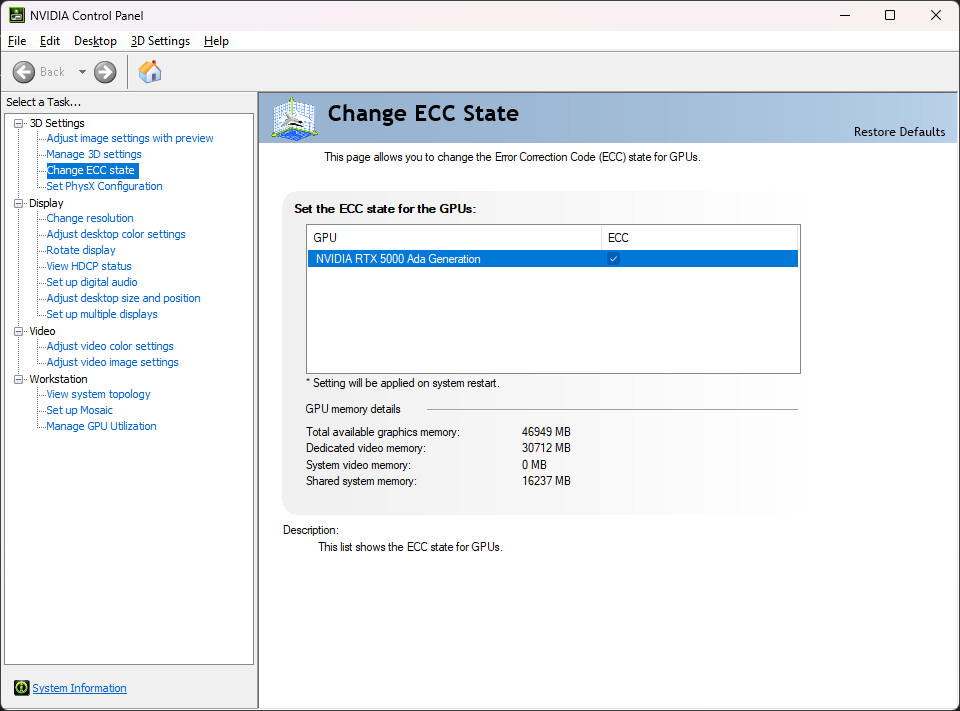
For professional workstations employing multiple GPUs and numerous screen connections, the NVIDIA Control Center provides essential Topology information. This feature includes details such as the system driver version, the four display output ports of the professional graphics card, and information about currently connected external monitors. This allows users to manage the GPUs and connected displays of their workstations more efficiently.
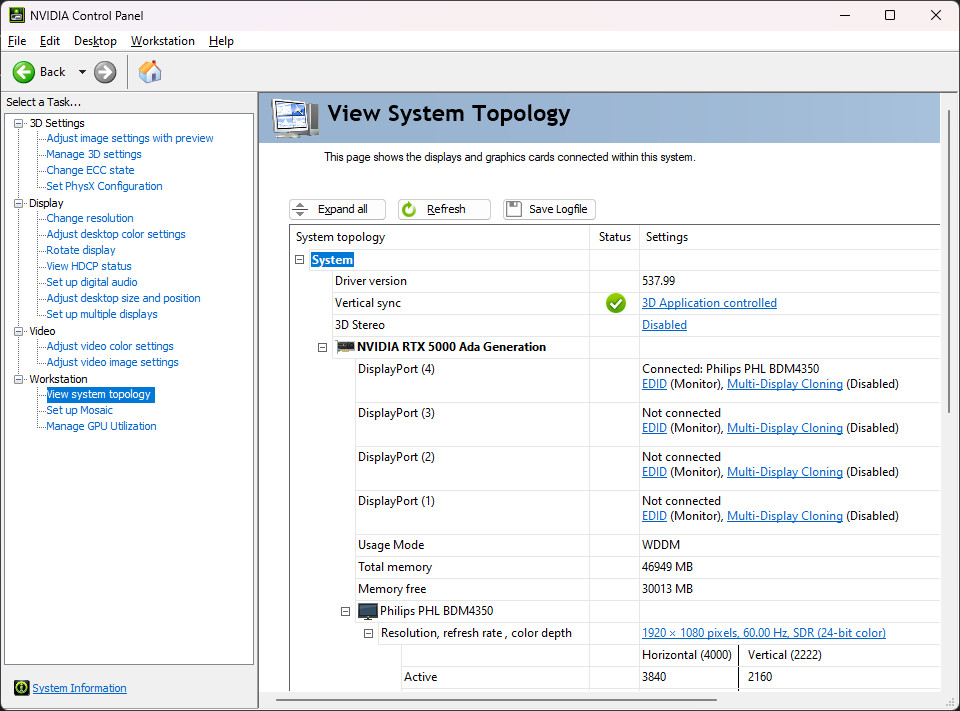
NVIDIA’s Mosaic technology for multi-display systems supports the integration of up to 16 monitors across 4 GPUs. Users can arrange the displays according to their specific usage environment and combine them into a single desktop. This technology also offers advanced multi-screen integration features, such as screen bezel correction and projector overlap, enhancing the overall user experience in multi-monitor setups.
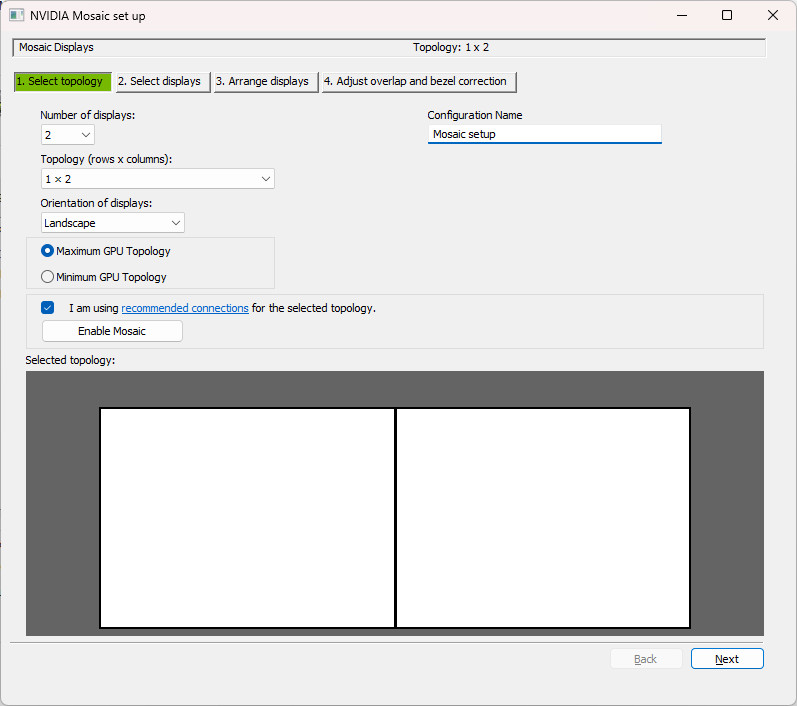
The RTX Desktop Manager software offers an enhanced tool for powerful desktop window organization and management. It allows users to control and arrange all windows across multiple screens directly within the software. Users can save their current window configurations as profiles for easy access. The software provides several predefined GRID splitting options, facilitating more efficient management in multi-monitor work environments.
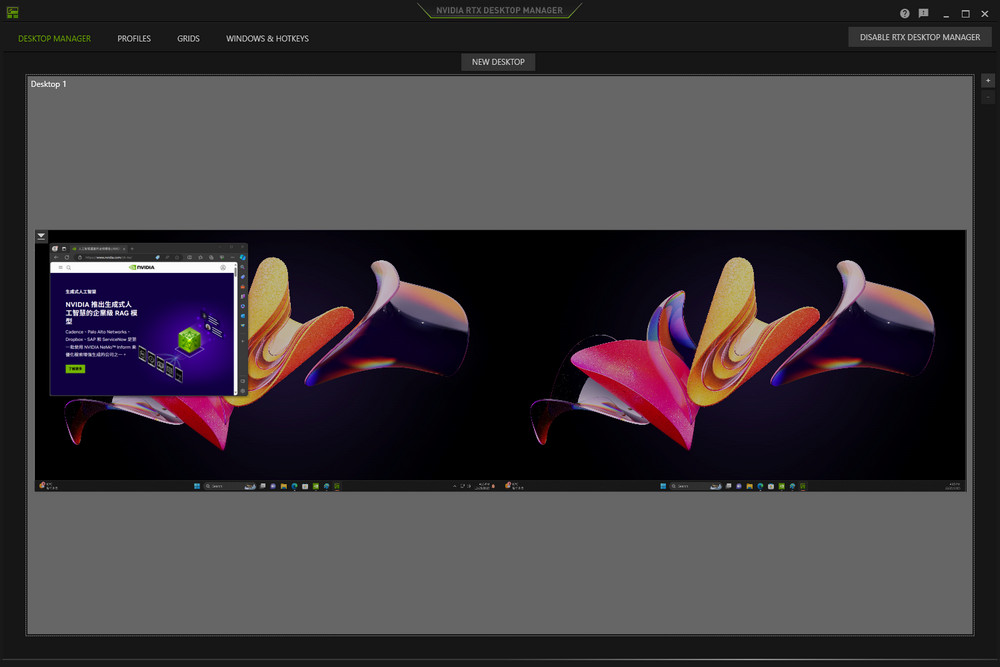
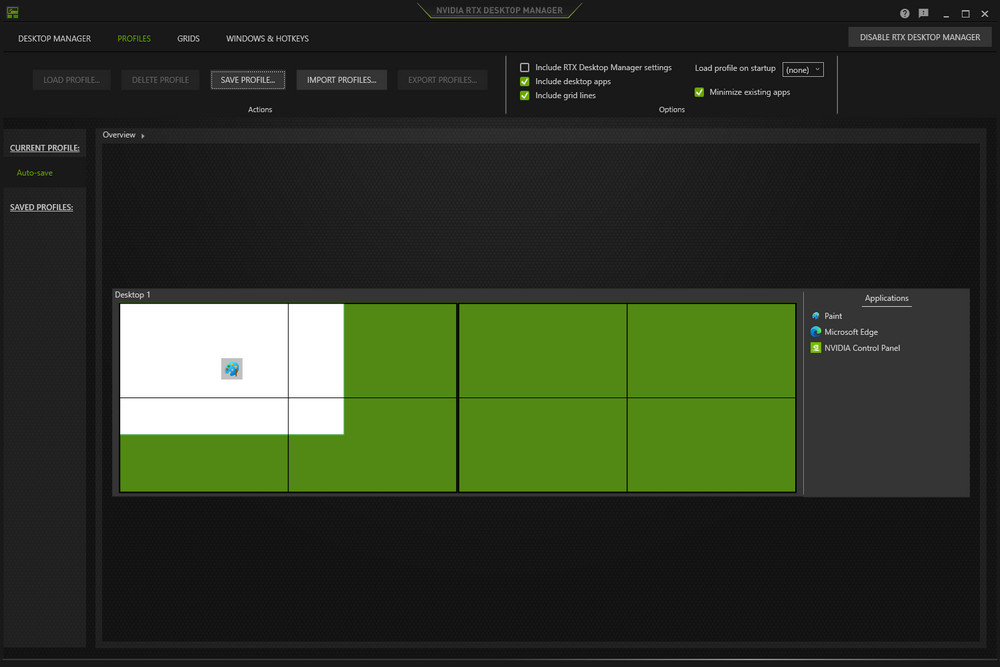
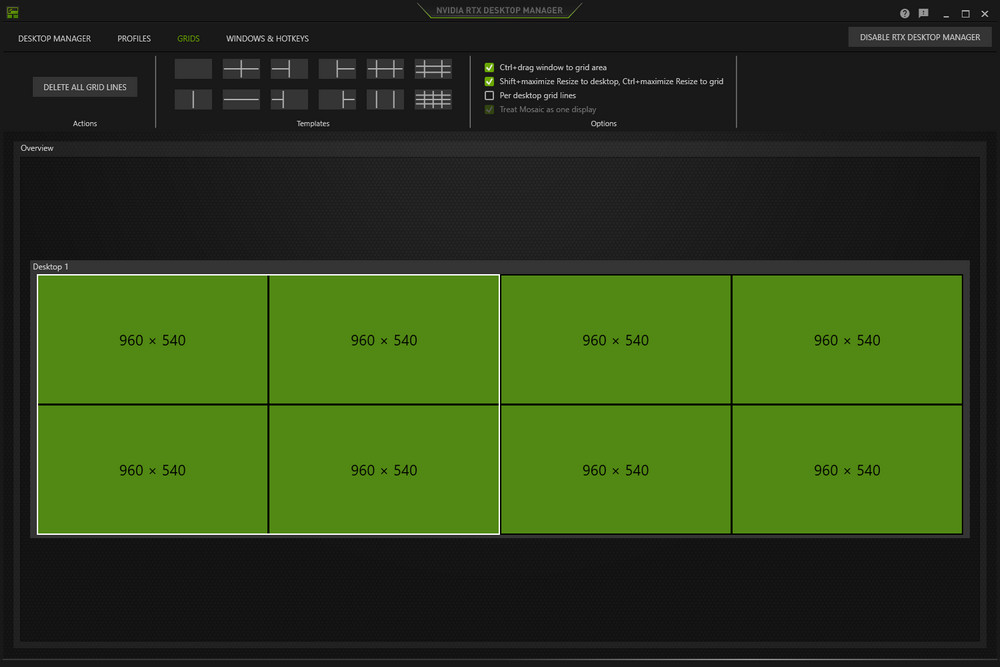
Within the NVIDIA Control Center, users have the flexibility to adjust the GPU’s usage mode. By default, the GPU is set to a mode that supports both graphics and computational tasks. However, for users focused solely on graphics tasks, there is an option to switch to a GPU mode specifically optimized for graphics functions.
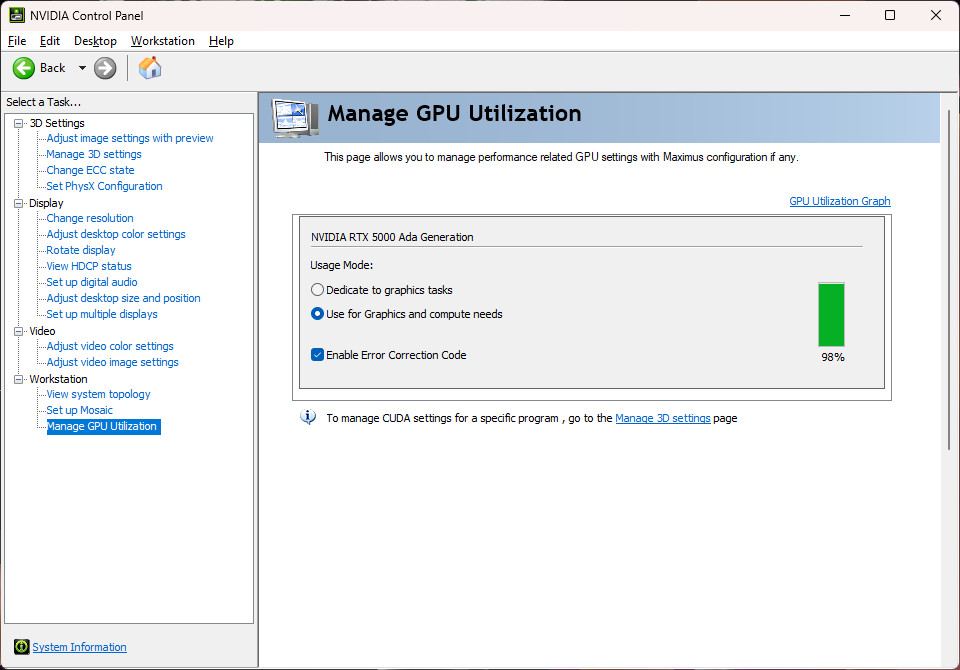
NVIDIA RTX™ 5000 Ada Generation Creation and Rendering Performance Test
To assess the rendering and computational performance of the RTX 5000 professional graphics card, professional benchmarks such as SPECviewperf, Blender, Vray, and OCTANEBENCH are utilized. The tests include DaVinci Resolve 18 for video output, Omniverse Creator, and Stable Diffusion.
Test Platform Specifications:
- Processor: Intel Core i9-14900K
- Motherboard: ASUS ROG MAXIMUS Z790 DARK HERO
- Memory: Crucial DDR5-5600 16GBx2
- Graphics Card: NVIDIA RTX™ 5000 Ada Generation
- System Drive: Solidigm P41 Plus 1TB PCIe 4.0 SSD
- Cooler: ROG RYUJIN III 360
- Power Supply: Seasonic VERTEX GX-1000
- Operating System: Windows 11 Pro 22H2 64bit, Resizable BAR On
- Driver Version: NVIDIA 537.99
Using GPU-Z to review the RTX 5000’s specifications, it features the 5nm AD102 GPU with 12,800 CUDA cores for rendering and 32,768 MB of GDDR6 memory (Hynix). The GPU’s default clock is set at 1155 MHz with a Boost of 2550 MHz.
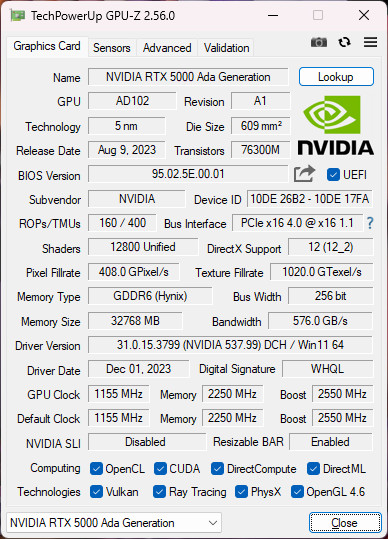
The latest version of CINEBENCH 2024 has fully integrated Cinema 4D’s default Redshift rendering engine, offering comprehensive tests for both GPU and CPU. This update allows for cross-platform performance comparisons, significantly enhancing the rendering test capabilities for CPUs.
In this updated benchmark, the RTX 5000 GPU achieved an impressive score of 20,137 points. This performance notably surpasses that of the mainstream processor, the i9-14900K, demonstrating the GPU’s superior speed.
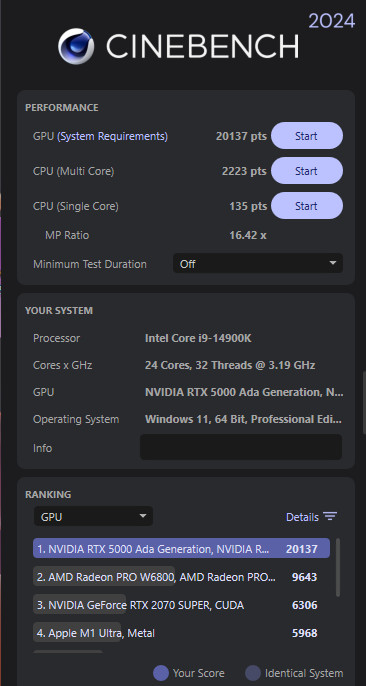
DaVinci Resolve 18 stands out as a video editing program that fully leverages GPU acceleration, incorporating powerful color correction and special effects features. It directly utilizes CUDA cores for computation, which significantly enhances the performance in video playback and output.
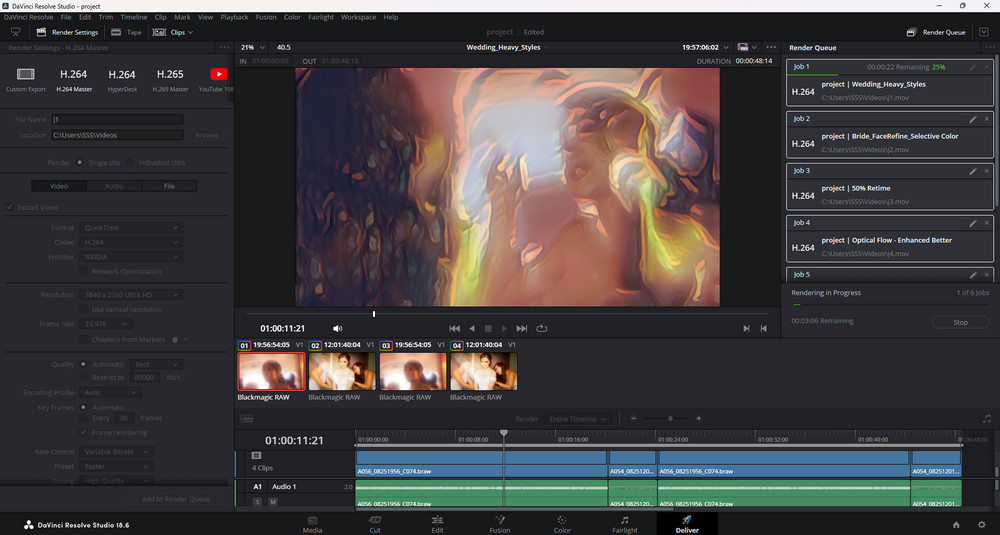
In the first set of tests using DaVinci Resolve 18, the project involved editing 4K Blackmagic RAW footage with a ‘Wedding_Heavy_Styles’ timeline. This video segment utilized numerous Resolve effects, including OFX: Light Rays, Glow, Sketch, producing a highly stylized film output.
The ‘Bride_FaceRefine_Selective_Color’ segment employed Face Refinement for facial tracking, highlighting the bride as the main subject with color marking. The 50% Retime and Optical Flow Enhanced Better segments utilized Optical Flow technology to reduce the video speed by 50%.
For ‘SuperScale2x 4K Source’, a 4K ProRES source video was used to create a 2x Zoom In on the main subject, resulting in a 4K output. ‘SuperScale4x HD_Source’ took an HD H.264 source video and upscaled it to 4K using Resolve’s Super Scale feature.
The RTX 5000, with its two eighth-generation NVENC encoding engines, demonstrates remarkable processing speed for 4K video output tasks. It can complete a task of stitching four HD videos into a 4K output in just 1 minute and 1 second, with other outputs being finished within a minute.
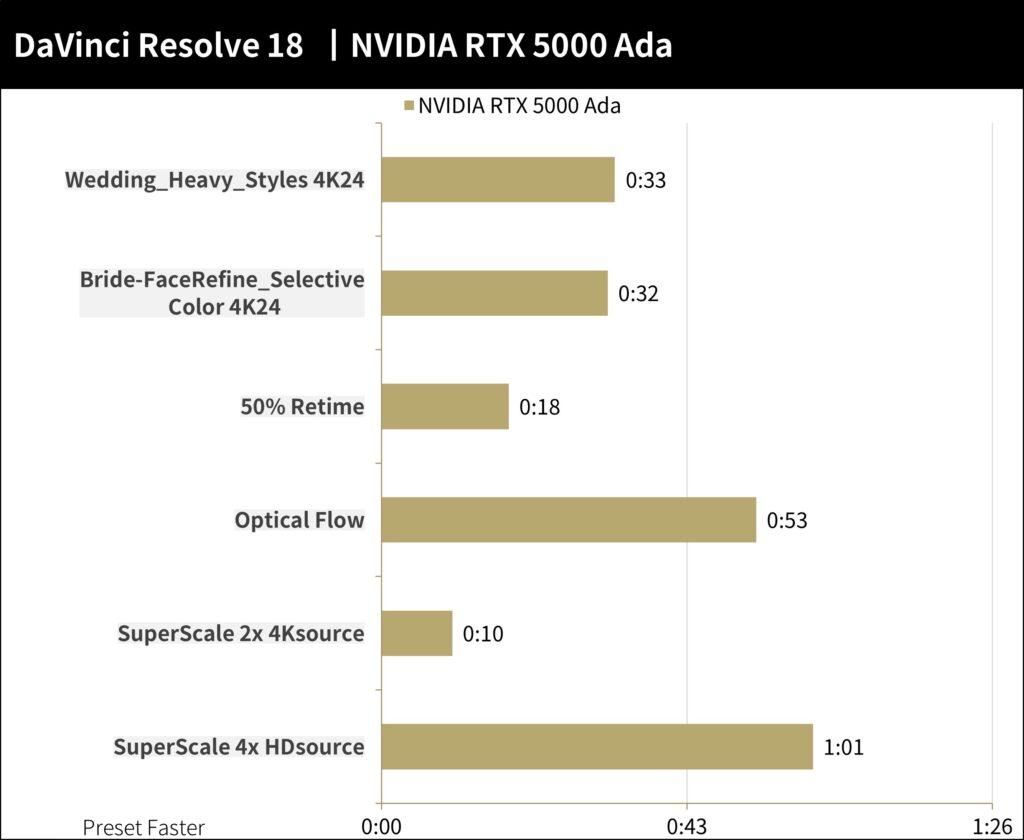
The second phase of testing focused on the dual NVENC encoding capabilities of the RTX 5000, specifically with AV1 and HEVC codecs. The test used a 44-second short film from the Blender Open Movie Project, ‘Tears of Steel.’ This film was available in both 8K Prores442HQ at 30FPS and 4K Prores422HQ at 30FPS formats, ideal for testing the performance of HEVC and AV1 encoded outputs.
The output settings primarily utilized the NVIDIA Encoder with the following configurations: Quality restricted to 80,000 Kb/s, Encoding Profile set to Main, Rate Control on Constant Bitrate, Preset on Faster, Tuning for High Quality, and Two Pass disabled. These settings were designed to rigorously test the encoding efficiency of the graphics card.
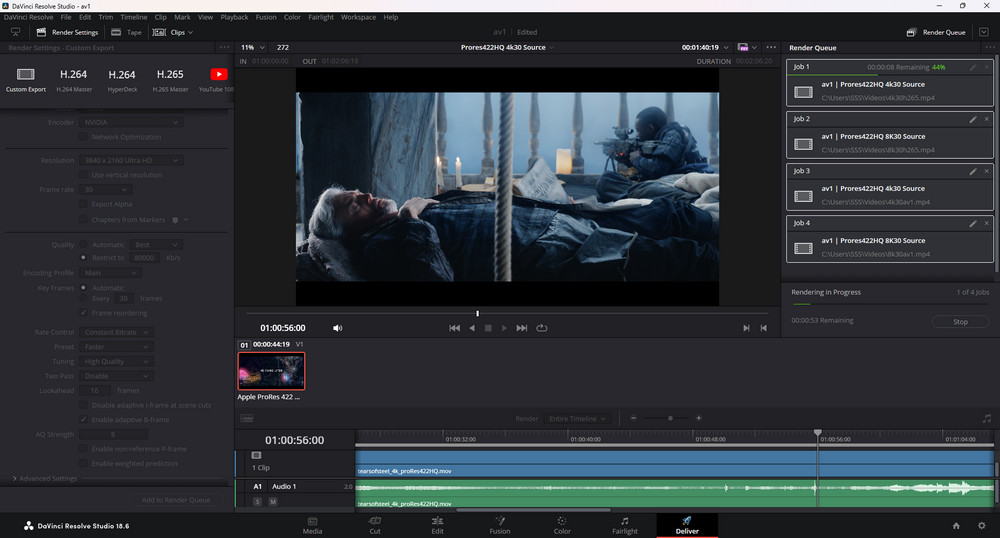
For the RTX 5000, handling 4K project outputs is notably effortless. When it comes to upscaling to 8K video output, the card demonstrates equally impressive performance, regardless of whether it’s encoding in HEVC or AV1 formats. This capability showcases the RTX 5000’s robustness in handling high-resolution video outputs with remarkable speed and efficiency.
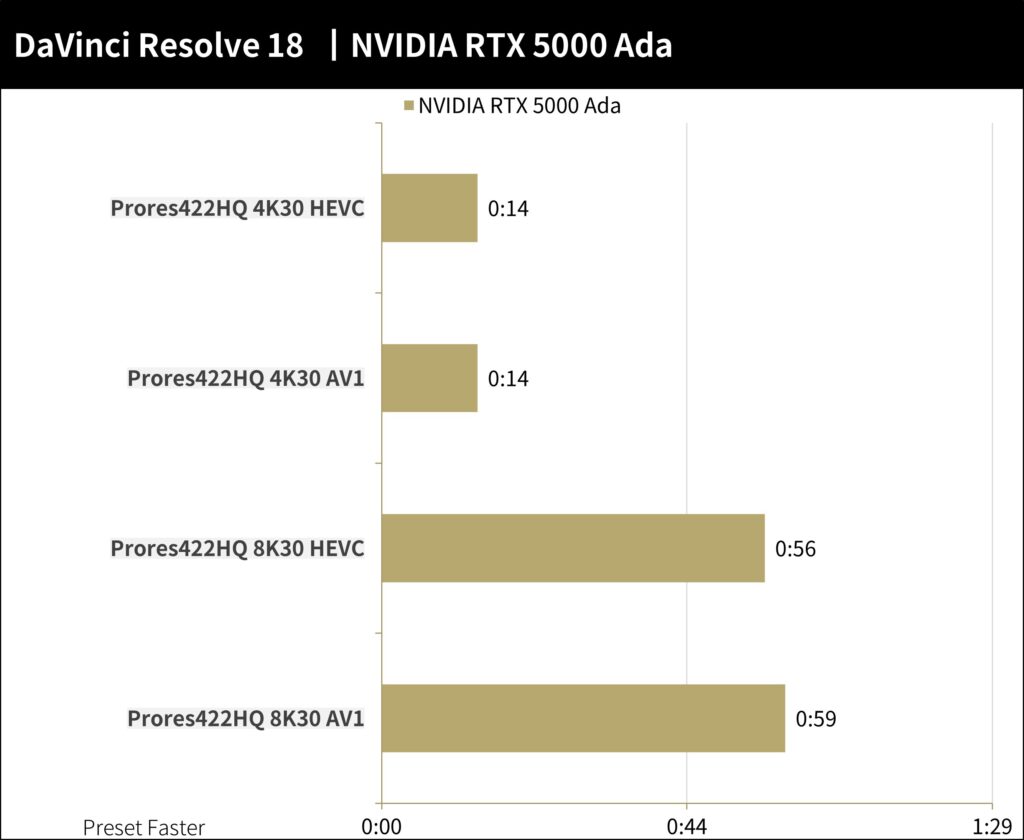
Blender is a cross-platform, open-source 3D creation suite supporting a wide array of 3D tasks such as Modeling, Rigging, Animation, Simulation, Rendering, Compositing, and Motion Tracking. The RTX 5000’s rendering capabilities were tested using Blender Benchmark 3.5.0, focusing on rendering specific demo projects.
In the Blender Benchmark tests, the RTX 5000 achieved impressive scores, recording 3146.377 points in the ‘monster’ scene, 1386.968 points in the ‘junkshop’ scene, and 1515.451 points in the ‘classroom’ scene. These results demonstrate the RTX 5000’s ability to meet the demanding rendering performance requirements of 3D creative work.
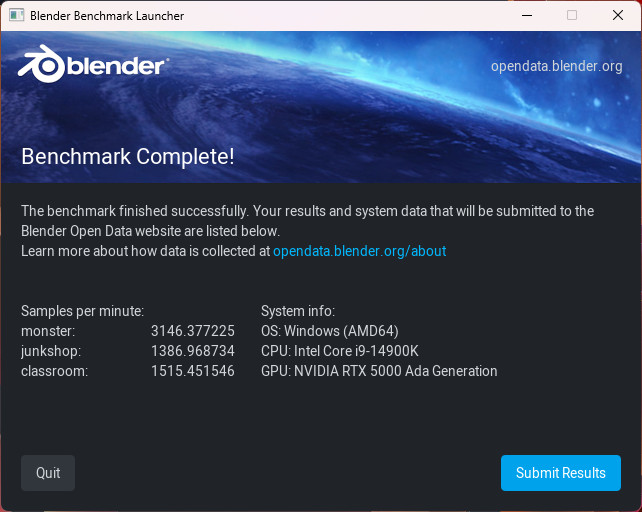
Developed by Chaos Group, V-Ray is a ray tracing rendering software designed based on physical laws. The V-Ray Benchmark tool specifically tests the ray tracing rendering capabilities of both CPUs and GPUs.
In the V-Ray tests, the RTX 5000 demonstrated its computational prowess. When using CUDA for computations, it achieved a remarkable rate of 2002 vpaths per second. With RTX computing, it further enhanced its performance, reaching an impressive 2474 vrays per second. These results highlight the RTX 5000’s exceptional capabilities in ray tracing render tasks.
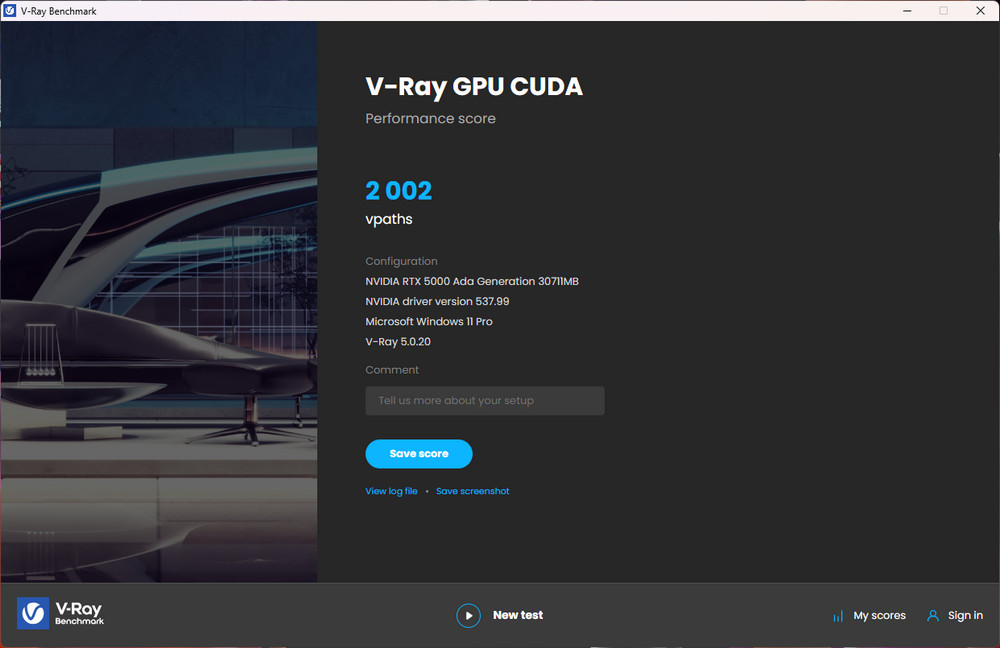
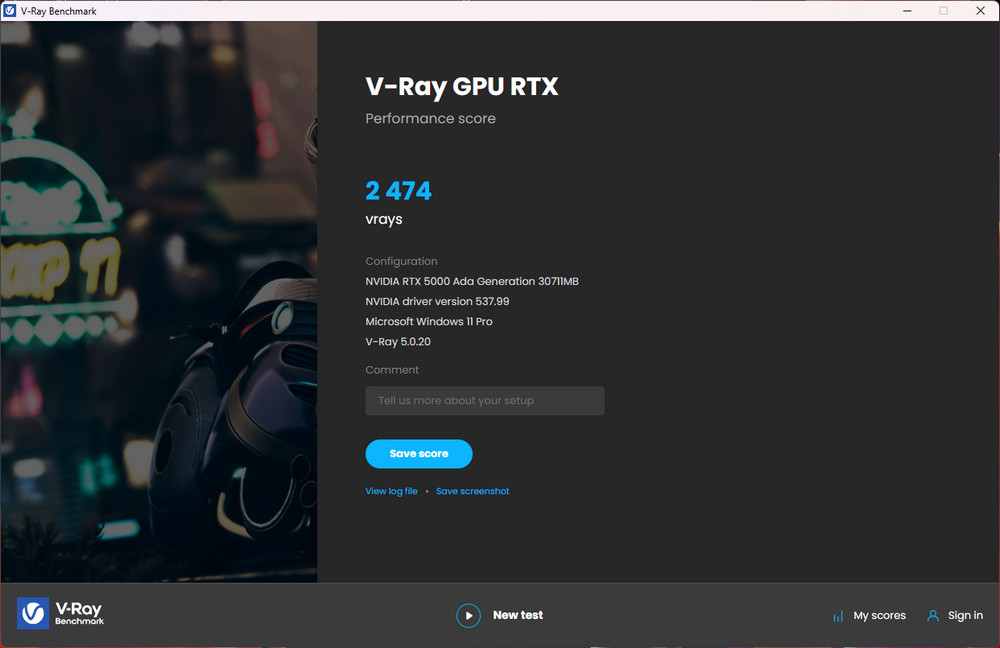
OctaneBench is a fast, standalone benchmarking tool centered around OTOY’s Octane Render. It fully harnesses the capabilities of RTX and CUDA technologies and supports mainstream 3D applications. This enables creators to achieve rapid, high-quality rendering outputs.
The test incorporates four different scenes along with core elements like Info channels, direct lighting, and path tracing. The RTX 5000 showcases commendable computational speed in these tests, satisfying the fast rendering needs of creators.
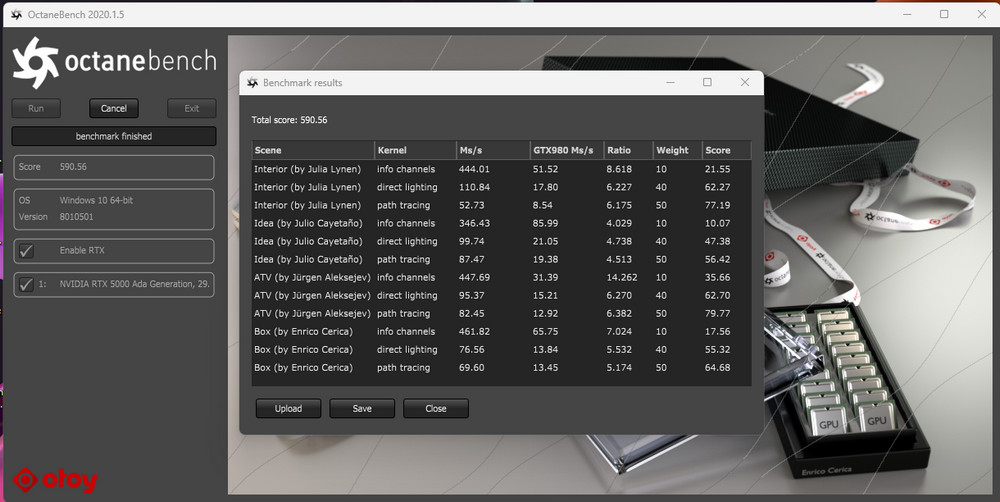
SPECviewperf 2020 is a standard graphics performance benchmarking tool developed for professional applications. It tests a variety of professional computer graphics software such as 3ds Max, Catia, Creo, Energy, Maya, Medical, SNX, and SolidWorks, focusing on graphics tests and engineering simulations.
Conducted at a resolution of 3840 x 2160, the test results are measured in FPS (frames per second). The RTX 5000 demonstrates high FPS performance across various tasks, providing sufficient graphics power for professionals in creative, simulation, and computational tasks.
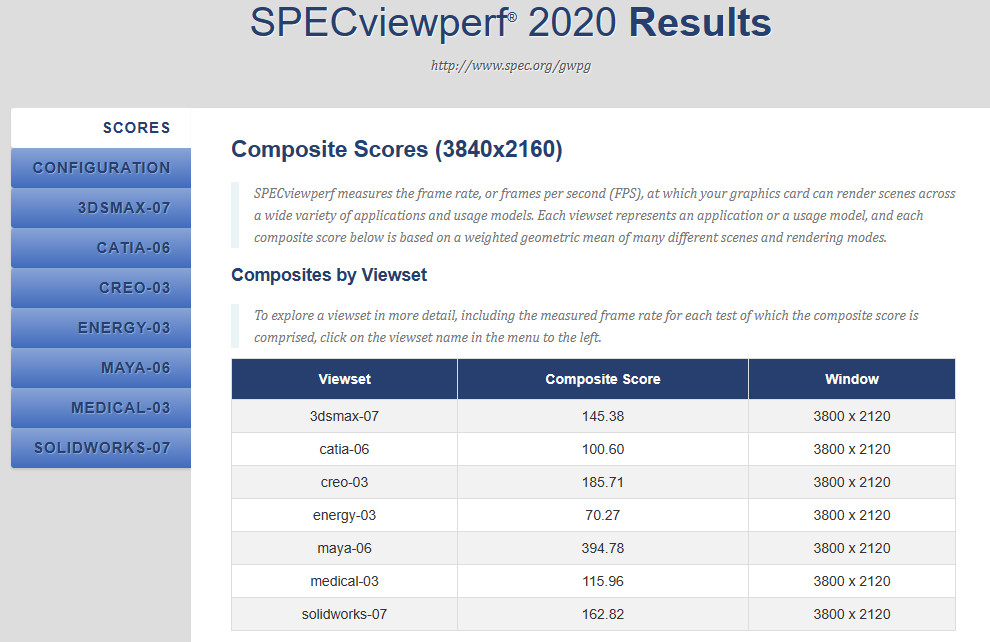
NVIDIA RTX™ 5000 Ada Generation Omniverse Creator Test
NVIDIA Omniverse is a collaboration platform that accelerates 3D design, seamlessly supporting major industry-standard 3D apps. It enables creators from around the world to work on 3D projects simultaneously, offering real-time rendering results. The platform also features capabilities like Digital Twin and robot training simulations.
For this test, we used Omniverse Create to perform real-time ray tracing and FPS performance testing with DLSS 3 acceleration. The tested projects included: ‘Campfire_Main_03_Flow3’, simulating the physical effects of a burning campfire; ‘Flowers4’, testing instanced geometry and particle flow animation; ‘Incense_Main’, assessing smoke simulation and reflective material changes; ‘JadeTiger’, featuring a detailed model with advanced jade material; and ‘Warehouse_Physics_Stage’, simulating a domino effect of collapsing shelves in a warehouse.
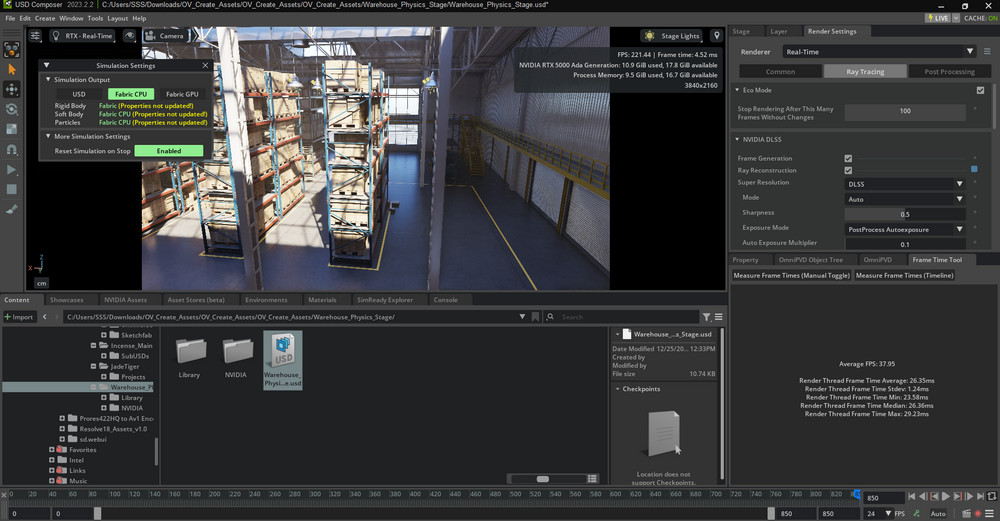
When tested under UHD ViewPort and DLSS3 Performance settings with the RTX 5000, the results showcased impressive FPS performance across different projects. ‘Campfire’ achieved an average of 42.49 FPS, ‘Flowers4’ reached around 33.19 FPS, ‘Incense_Main’ delivered an average of 45.63 FPS, ‘JadeTiger’ performed at 45.69 FPS, and ‘Warehouse_Physics_Stage’ recorded an average of 37.95 FPS. These results demonstrate the RTX 5000’s robust performance in handling diverse and demanding rendering tasks.
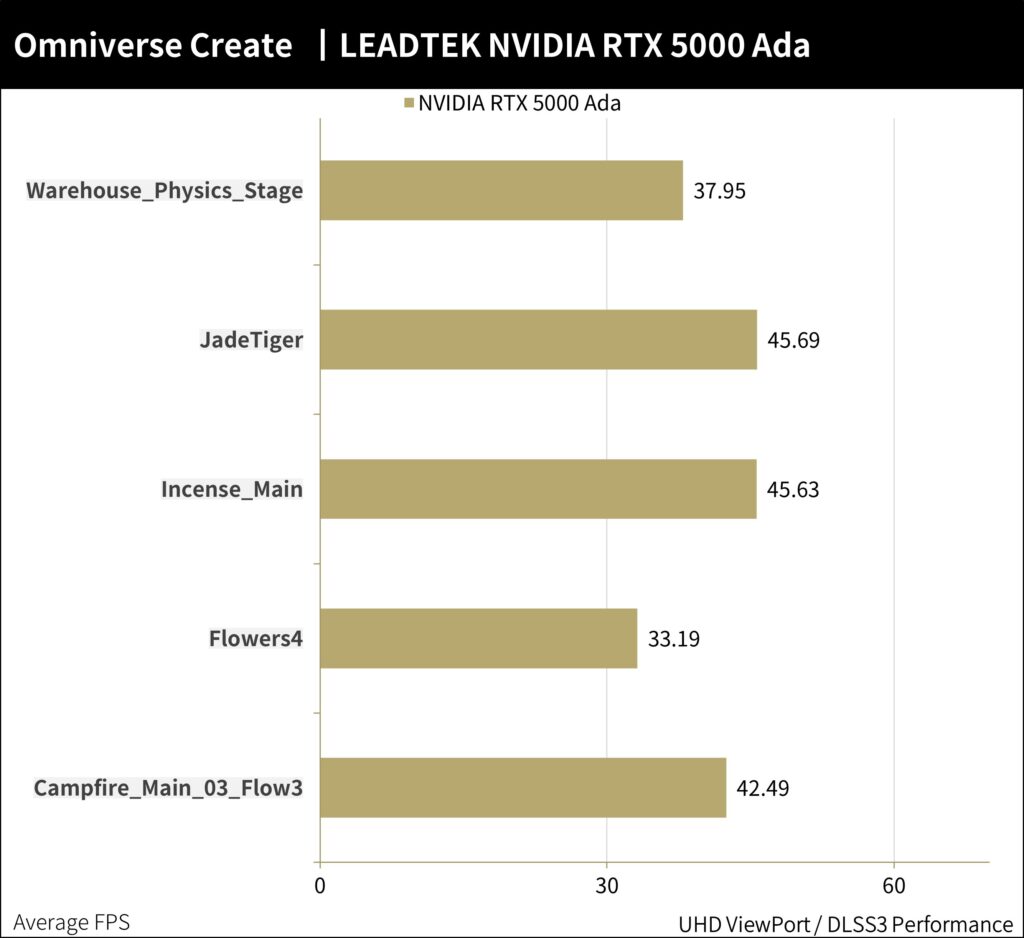
NVIDIA RTX™ 5000 Ada Generation AI Graph Stable Diffusion Test
The widely acclaimed AI deep learning model, Stable Diffusion, known for converting text to images, has been manually installed using the standard version released by Automatic1111. It has been enhanced with TensorRT optimization to maximize GPU acceleration performance. This integration ensures that Stable Diffusion operates at peak efficiency, leveraging the best of GPU capabilities for high-quality image generation.
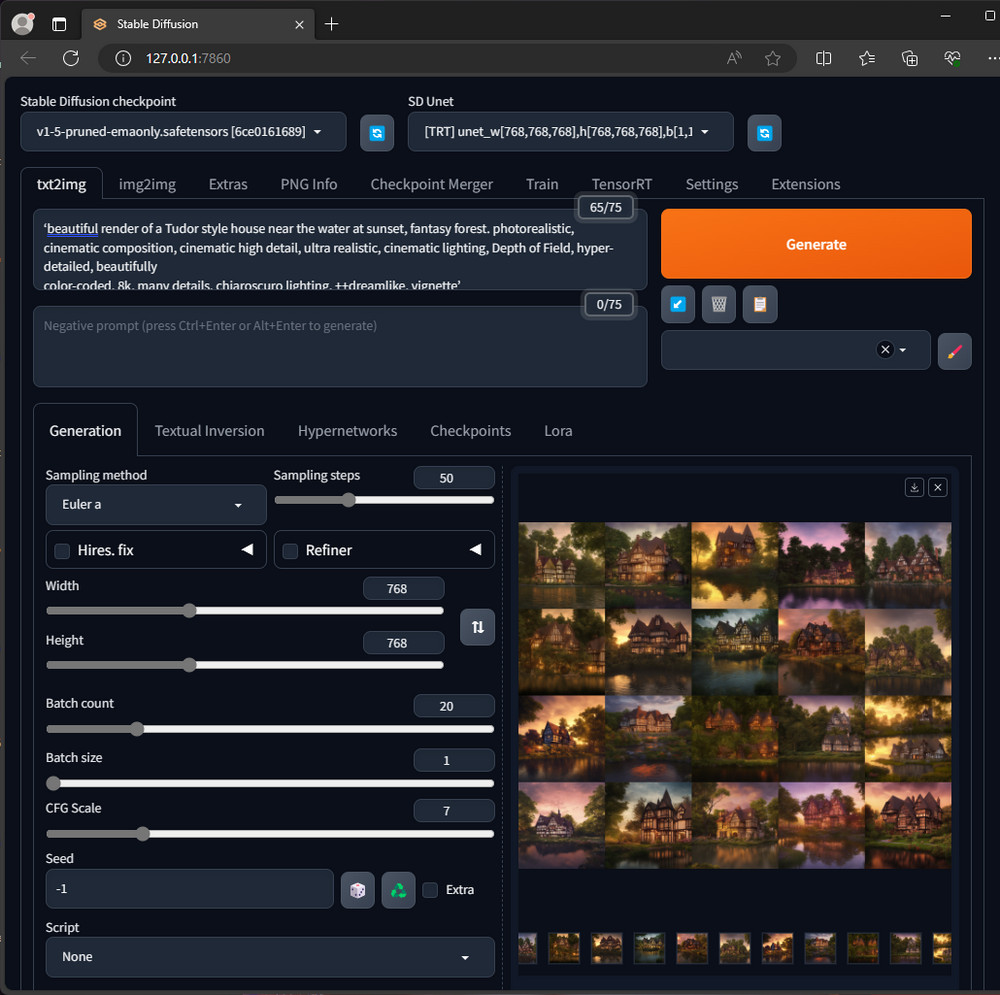
For the test settings and specific commands, refer to the details provided below the images. In the tests, the RTX 5000 with TensorRT optimization achieved a remarkable image generation speed of 18.46 images per minute. This performance significantly surpasses that of the standard version by Automatic1111, which produced only 5.77 images per minute. This marks a substantial performance increase of 220%, showcasing the RTX 5000’s enhanced capabilities in AI-driven image generation.
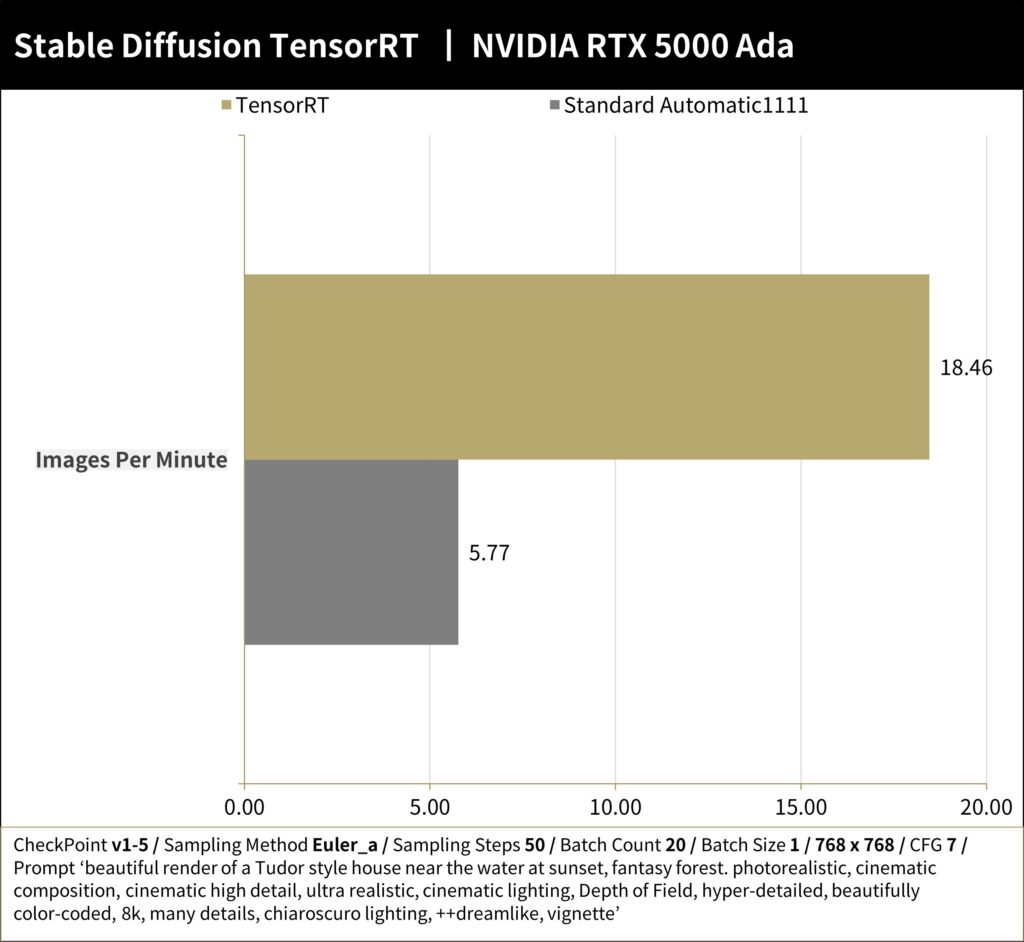
NVIDIA RTX™ 5000 Ada Generation Power Consumption and Temperature Measurement
The power consumption and temperature of the graphics card were tested using projects in Omniverse and DaVinci Resolve 18, with the GPU temperature and power usage recorded after three runs. For peak power consumption testing, Furmark was used to stress the hardware. The power consumption was measured using NVIDIA’s PACT tool, which monitors the wattage provided by the PCIe slot and the 12V power supply.
In terms of temperature, the RTX 5000 peaked at 78.5°C, with Omniverse 3D rendering reaching 75.9°C and DaVinci Resolve 18’s 8K video output showing a lower temperature of just 63°C. The software indicates that the default temperature limit for the GPU is set to 84°C.
For Total Board Power (TBP) consumption, the Furmark stress test showed a peak average power consumption of 250W. Omniverse 3D rendering maintained a power usage of 237.5W, while DaVinci Resolve 18’s 8K video output required only 131.9W of power.
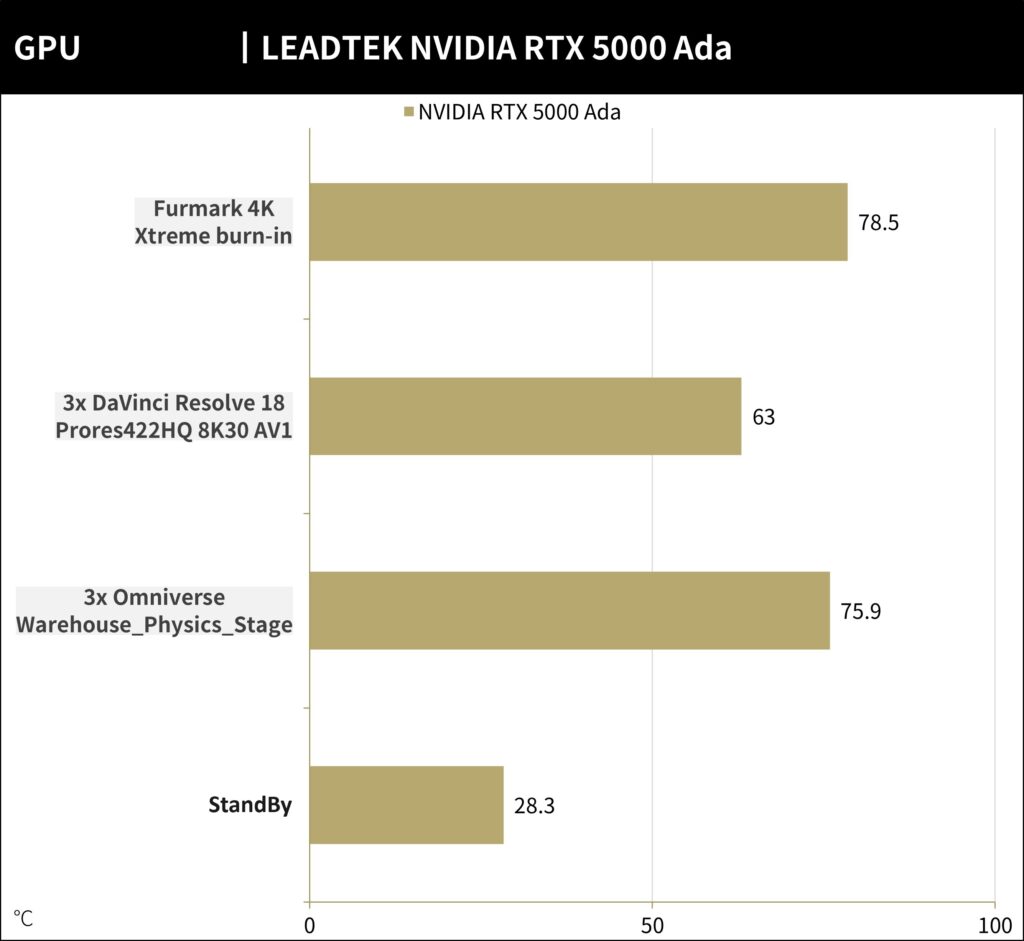
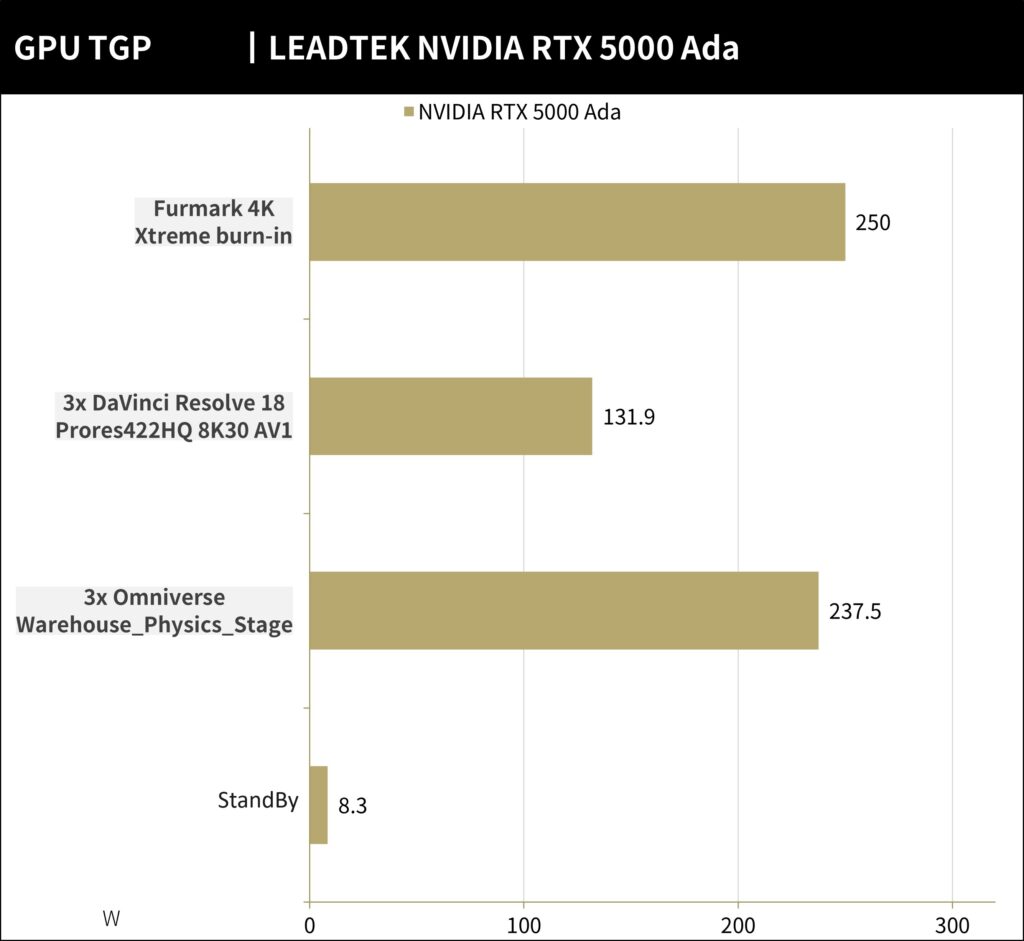
Summary
The RTX 5000 professional graphics card, with its AD102 core, 100 Streaming Multiprocessors (SMs), 32GB GDDR6 ECC memory, and 250W power consumption, demonstrates outstanding performance across various applications. It excels in tasks such as 8K AV1 video output in DaVinci Resolve 18, real-time ray tracing UHD simulation in Omniverse Creator, and generative AI image inference in Stable Diffusion.
Positioned more affordably and with lower power consumption than the flagship RTX 6000, the RTX 5000 offers a compelling choice for professionals. The card’s suitability varies based on project-specific VRAM needs and multi-card configurations. Its 26.7cm length, 2-slot size, and blower fan design, coupled with a 250W power consumption, make it an accessible upgrade for many workstations and servers.
NVIDIA provides a comprehensive software and hardware ecosystem for professional users, including GPU virtualization, Mosaic, RTX Desktop Manager, and NVIDIA-developed SDK tools. This integration spans diverse fields such as AI, data science, data centers, cloud, design, simulation, robotics, high-performance computing, and autonomous vehicles, enabling solutions for industry-specific challenges through GPU acceleration.
Finally, NVIDIA’s professional graphics cards are supported by Leadtek Technology’s excellent after-sales service. This includes a three-year warranty with door-to-door service and a toll-free customer service hotline ‘0800-600-206’, offering professional users the most reliable and stable creative and computational experience.
If this article is helpful for you, please share this article with your friends on social media. Thank you!
This article is based on the personality of the reviews. You are responsible for fact-checking if the contents are not facts or accurate.
Title: NVIDIA RTX™ 5000 Ada Generation: A Comprehensive Review of the Next-Gen Professional Graphics Powerhouse